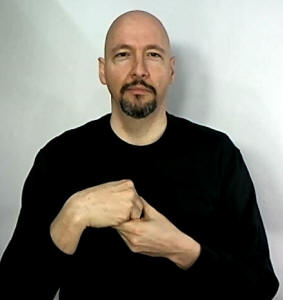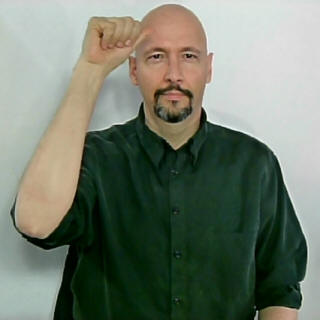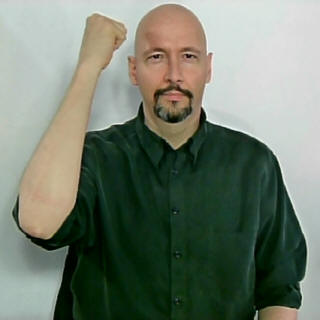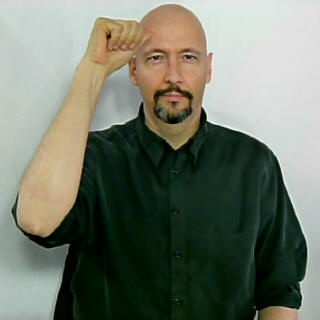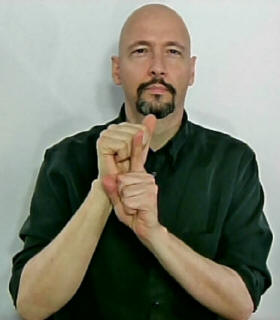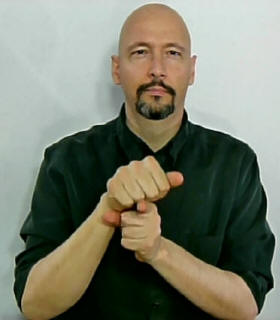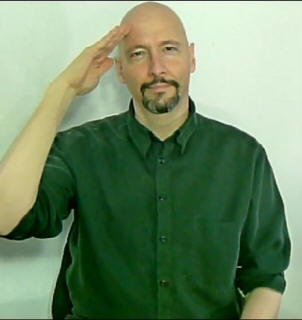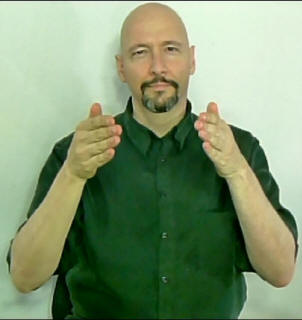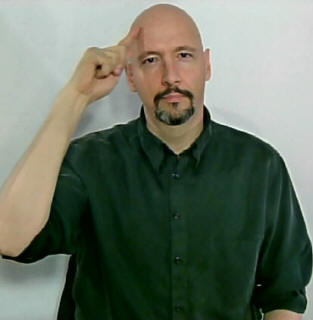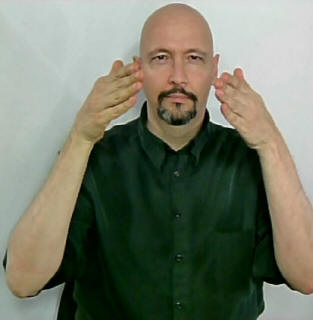American Sign Language: "autism"
AUTISM / internalize / include-within-self
This sign means more than just autism. It only means autism or autistic in context.
Also, do not think that just because "some" of the interpretations of this sign may seem negative that the sign itself is negative. In context it simply means "autism." In other context's it has other meanings. This sign is a combination of the sign for "involved" and the "self" location near the body.
In other contexts this sign could loosely infer the idea of "self-involved," "self-absorbed," or "in your own world."
[See the email below.]
In a message dated 2/11/2011 3:23:55 P.M. Pacific Standard Time, Sarah Leathers writes:
Hi! My name is Sarah Leathers, and I teach 6th grade at the Jean Massieu School of the Deaf in Salt Lake City...
I was reading some of the dialogue about the sign for "autism." Colleagues at my school use a sign that looks just like "include" (similar to the sign on your website for "involved") but the non-dominant hand is near your chest—as if you were signing "included into me" but your dominant hand starts with the palm facing up—not down.
Hope that makes sense. J
Sarah Leathers
6th Grade Teacher
sarahl (at) usdb.org
In a message dated 1/21/2011 6:56:22 A.M. Pacific Standard Time, a web user from Minnesota writes:
Hello Bill. I do therapy with children with Autism, 2 of whom are Deaf, with Deaf family members. The sign most accepted by the autistic community is actually one that closer to "internalize" with left hand a closed C shape and the right hand and open 5 then to a closed 5 inside the left hand in front of the chest. Does that make sense?
Thank you.
From Minnesota
(Please refrain from using my name for privacy reasons related to work) Thank you!! Sent from my Sprint BlackBerry®.
In a message dated 12/25/2010 4:56:22 P.M. Pacific Standard Time, a student writes:
"I read [elsewhere, not at this site,] about the AUTISTIC sign [being made] with [a] claw-hand showing [a] turning bicycle wheel in front of [the] signer's face. I also read the (apocryphal?) story of the group of Deaf who met an Autistic boy engrossed in a spinning bicycle wheel and created this sign. I have seen this sign (or a modern mutation?)* used, but it is hard for me to pick-up in real-time ! (Ha ha: all signs are hard for me to pick-up in real time, that's why I love the still-images at ASLU.)
I'm also wondering if you can do a poll or know any other versions of AUTISTIC, maybe something more 'PC'. (An endonym?) Also this sign strikes me as very specifically about classic autism; I wonder about a sign that would be more inclusive of highly verbal people, like myself, who Identify with Autism.
Good day!
(Name on file)
Dear Student,
I've seen many signs for "AUTISM."
Some versions that have come and gone include:
● A-hand near the head: For quite a few years in the region where I lived it was common to see the sign done with an "A" handshape near the forehead with a double twist. Later, when it became popular to de-initialize signs (as in to remove the English initial letter handshape from a sign and replace it with a more basic handshape when possible) some people started doing that version with flat hand.
● A-hand on index finger: At one time it was common to see a sign that placed an "A"-hand onto an INDEX-finger and moved both hands forward-and-down twice. (Now considered inappropriate.)
● Flat-hand moving from the head and joined by other flat hand to indicate "narrow mind" or a focused mind: "MIND-NARROW-[focus]."
==================================
Historical notes:
Language evolves. As of 2023, my wife (Bee) signs "autistic" using the "include"-(near chest) sign. Many years ago (when I was originally typing out various notes for this page) my wife wandered in and I asked her how she signs "autistic." She signed it using the version that places an "A" onto an INDEX-finger and moves both hands forward-and-down twice.
I showed her my (former) version (the "A" twisted twice by the head) and she replied, "That's stupid." (Deaf blunt, yay! To be clear, she wasn't saying that I was doing the sign for "stupid" -- she meant that she didn't like the version of "autistic" that I was showing her.
Me: Really!? [showing sign]
Her: Stupid! [emphasis]
[Note: Normally my wife is a very nice person. I think it has just been "one of those days" for her. Or perhaps she was just being very silly or blunt with me since I'm her hubby. I reckon if anyone else asked her she would be more polite. Then again, someday she might read this and whack me upside the head.]
Later (again though this was many years ago) I just asked an older friend of mine how she would sign "autistic." She is Deaf of Deaf, married to Deaf, with Deaf children (etc.). Grandmotherly type. At first nothing came to mind. Then after she thought for a moment, she came up with the "A-hand near the head" version of the sign AUTISTIC. I showed her the "A-hand on INDEX-finger" version and she didn't seem too enthused. Her husband who happened to be nearby (they are a very close couple) mentioned that he didn't care for the "A-hand on INDEX-finger" because it would be easily confused with the sign "FOOL-people-repeatedly." (Heh.) I showed them the "claw-hand moving in a bicycle pattern near the head" version and they both didn't like that at all.
-- Dr. Bill
AUTISM / autistic - (initialized version) (not recommended)
While I don't recommend this version it is interesting to note that at one time it was fairly common.
AUTISM / autistic - (archaic regional version) (not recommended).
Do a double movement and move both hands forward and down together (remaining in contact) at the same time so as to distinguish this sign from "to-FOOL."
AUTISM / autistic - ("mentally-FOCUSED") (not recommended)
This was a version that started to spread but just fizzled out.
Note: The beginning handshape really isn't an issue on this sign. In the example here, I'm using a flat hand because the beginning handshape is "anticipating" the ending handshape.
AUTISM / autistic - ("mentally-FOCUSED") (not recommended as a sign for Autism)
This sign is a combination of "mind, brain, think, thought, etc." and "focus."
This sign could be considered either positively or negatively.
For example it could mean "mentally focused" or it could also mean "narrow minded" if you used a negative facial expression with it.
Protologism: "COLORFUL-MIND"
Question:
Discussion:
A student wrote:
Hello! I am a proud autistic woman and am not fond of the traditional sign for "autistic" as it seems based on misrepresentations perpetuated by the medical community. I saw a fellow autistic who uses ASL as her primary language use a new sign (open palm to head, wiggle fingers) sort of like "colorful mind" or "colorful thoughts." I MUCH prefer this sign and she said she was taught it by a Deaf woman, but I don't know her well, and wanted to check with you to make sure it came from the Deaf community before I use it. Have you seen this as an emerging sign? Thanks!
[name removed to protect the person's privacy]
Response:
Have I seen the colorful-thoughts sign proposed to mean Autism? Yes.
Do I consider the colorful-thoughts "the" sign for Autism? Not-yet. I consider it a protologism that (as of 2023) has some conflicts and a significant amount of resistance among native Deaf Autistics. (It will be interesting to come back and revisit these comments in ten years).
The colorful mind sign may or may not spread for autism. At this point (2023) I consider it a protologism.
(For a definition of protologism, see: https://www.lifeprint.com/asl101/topics/protologism.htm )
You've asked my opinion and my opinion is that if a person who is truly of the Deaf Community and immersed in Deaf Culture were to have coined the colorful-mind sign it seems to me they would have used it to describe neuro-divergence rather than autism. In my humble opinion the colorful-mind sign is a perfect fit to the concept of neuro-divergence because the sign literally uses the handshape, movement, and internal-movement (fingers wiggling) of the sign for "diverse" done at the location of the brain (i.e. "neuro").
Again, that is my opinion.
It will not be my decision though -- it will be that of the community as a whole, over time, that settles on how to sign "Autism" -- hopefully led and inspired by Deaf individuals who also are autistic.
You state that you are a proud autistic woman.
Since you have invoked the concept of pride -- I'm going to mention that there are other groups that have been labeled by external communities. Some of those groups have chosen to reclaim and redefine their labels with pride.
The labels may have started out as insensitive or even insulting but over time in-group members chose to put the same labels on their shirts and banners and in the faces of the mainstream community. For example, Deaf people (those of us who are culturally Deaf) do not want to be called hearing impaired or any other (so called) externally-applied euphemism -- we wish to be called Deaf.
Whatever is or becomes the currently most commonly recognized sign for Autism / Autistic is not static in its representation as to what it means or represents. A word's origin is not necessarily its current or eventual meaning. The currently (2023) most common sign for Autism (INCLUDE-(near-the-chest)) can just as easily be associated with the terms "inclusion" / "inclusive" / "involved" / and "beauty" as in "beautiful inside" -- if a person or a community were to choose to promote such an associated meaning.
Anything can be painted in either a positive or negative light.
For example, consider for a moment a different angle: The colorful-mind-(Autism) sign could (if someone were to choose to do so) be negatively interpreted as "random thoughts," "thoughts randomly pouring from the brain," "flutter-brained," or even "scatter-brained." Again, if someone were to choose to purposely be negative regarding that sign they could point out that the protologism is a simple shape and movement change away from "mind-blown."
According to news-medical(dot)net "The term autism first was used by psychiatrist Eugen Bleuler in 1908. He used it to describe a schizophrenic patient who had withdrawn into his own world. The Greek word ''autós'' meant self and the word “autism” was used by Bleuler to mean morbid self-admiration and withdrawal within self."
Language evolves. You have seen the existing sign used by many native Deaf for Autism and decided you don't like it. I'm curious if you have proposed or decided you like better some other protologism for the English word Autism yet? Have you contacted any English Dictionary lexicographers and suggested to them that they should remove the English headword "Autism" from their dictionary and replace it with the phrase "colorful-thoughts?"
Or have you simply decided to be proud of the (English) word Autism and (re)-claim it and tell the world of your pride?
If you are able to feel pride while using the English version of the label for your condition (despite that word's external, medical origins) -- then I would suggest that the same standard or process could apply to the existing ASL sign for Autism -- if you or others made such a choice.
Do I have a problem with DEAF AUTISTIC people choosing their own labels? Certainly not. That is the way it should be.
I am however, not a fan of people who overstate their Deafhood or involvement in the culturally Deaf community as a form of clout-gathering in order to evangelize changes to ASL that are not organic. Language colonization by outsiders is an issue -- even if those outsiders consider themselves insiders.
Recall how I stated that I personally like the colorful-mind sign for neuro-divergent? My wife can't stand it. She also can't stand it being used for Autism and she became rather passionate in her statements to me moments ago when I asked her about it and signed that Deaf people who are themselves Autistics prefer the traditional sign for Autism! (She was adamant.) You can add that to your opinion list if you would like. Will she eventually change her mind? She might someday -- that is the beauty of language and language adoption.
I have colleagues at the university who feel (insist?) that the right approach to signing autism is to spell AU.
Language evolves. I try to be descriptive in my efforts rather than prescriptive. My goal is mainly to reduce language deprivation of Deaf children and do so in a way that is respectful of all humans. It matters not to me which signs Deaf Autistics eventually settle on for their own labels. It matters greatly to me that there are signs with which we can discuss autism. As of 2023 the vast majority of times I see the concept of autism signed it is done with the "inside" sign near the chest. Those who are signing it seem almost certainly doing so as a way to communicate the concept of autism -- not to connote any sort of secondary opinion about people who are autistic.
ASL interpreters would do well to know several different signs for Autism and then sign it the way their current Deaf client signs it.
Warm regards,
Bill
*
Want to help support ASL University? It's easy:
* Another way to help is to buy something from Dr. Bill's "Bookstore."
* Want even more ASL resources? Visit the "ASL Training Center!" (Subscription
Extension of ASLU)
* Also check out Dr. Bill's channel:
www.youtube.com/billvicars
You can learn American Sign Language (ASL) online at American Sign Language University ™
ASL resources by Lifeprint.com © Dr. William Vicars

